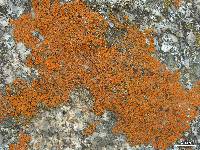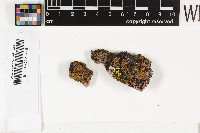
Consortium of Lichen Herbaria
- building a Global Consortium of Bryophytes and Lichens as keystones of cryptobiotic communities -
- Home
- Search
- Images
- Species Checklists
- US States: O-Z >
- US National Parks
- Central America
- South America
- US National Parks
- Southern Subpolar Region
|
|
|
|
Family: Teloschistaceae
[Caloplaca parviloba Wetmore] |
Nash, T.H., Ryan, B.D., Gries, C., Bungartz, F., (eds.) 2007. Lichen Flora of the Greater Sonoran Desert Region. Vol 3. Life habit: lichenized Thallus: squamulose, subsquamulose, without elongated lobes; prothallus: absent surface: orange, smooth, lobulate cortex: cellular, 14-42 µm thick, granules absent; medulla paraplectenchymatous, without granules Apothecia: adnate, 0.2-0.5 mm in diam., lecanorine disc: orange, flat, epruinose margin: persistent, flush; thalline margin present or absent, concolorous with thallus; proper margin visible, concolorous with disc parathecium: cellular (paraplectenchymatous) including exciple below hypothecium epihymenium: golden, present, K+ red, 10%N-, cN-, C- hymenium: hyaline, 40-70 µm tall paraphyses: 1-3 tip cells slightly swollen, with few branches; subhymenium hyaline asci: cylindrical, 8-spored ascospores: hyaline, 1 locules, ellipsoid, 11-14 x 5.5-7 µm, isthmus 3-4 µm, spore end wall thin Pycnidia: present, mostly immersed, ostiole orange Spot tests: apothecial margin K+ red, 10% N-, cN-; thallus K+ red, 10%N-, cN-; medulla IKI- Secondary metabolites: unidentified anthraquinones. Substrate and ecology: on non-calcareous rocks or occasionally on calcareous rocks World distribution: southwestern North America and northern Mexico Sonoran distribution: southern California, Arizona, Baja California, Baja California Sur, Sonora, and northern Sinaloa. Notes: Caloplaca parviloba has more elongate lobes than the other species in the squamosa group but never is as ascending or squamulose as C. squamosa. Sometimes the lobules are very small but they never develop soredia and usually on some places on the thallus there are more elongate lobes or lobules. It is somewhat intermediate between C. subsoluta and C. squamosa but those species never have the small marginal lobules. |
Powered by Symbiota





















